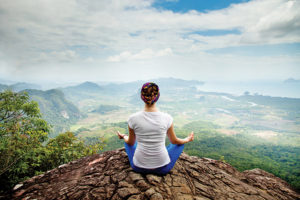By Cynthia Gran –
It’s easier to tell a lie
than it is to tell the truth…
It’s easier to drag your feet
than it is to be a man…
It’s easier to see the book upon the shelf,
Than to see yourself
—See Yourself, George Harrison
“The outer world, all that you see with your eyes, including the planets, the stars, and the universe are not as great nor vast as the space that lies deep within you. It is accessible through meditation, but you have never explored inside.” Say what?
When I heard that at age 17, I sensed my life would change. I was deeply inspired to practice yoga and meditation as well as tune into my inner world. I knew I was meant to continue on this path. I was ready for heaven on earth! Yet, the path of yoga has not been easy for me. I have had an especially hard time with meditation.
I learned the techniques of yoga over several years with many teachers and then began to teach classes and workshops. Merely learning techniques is the easy part. Some say we are called to teach in order that we may learn more comprehensively. But, practicing proficiently and routinely is entirely different. For years I had a daily routine that was satisfying yet it left me unable to reach the subtler stages of concentration that leads to a deeper experience of true meditation.
My meditation practice wasn’t always successful in large part because I disregarded daily basic training. I didn’t sufficiently take the time to employ the necessary preparations for a sustained amount of still sitting. I spent years skipping very important steps. I was just not self-disciplined enough. I didn’t implement enough hatha yoga asanas, develop sufficiently calm, deep breathing or apply deep relaxations in my routine. These preparatory steps together form an important basis for meditation.
To begin, hatha yoga asanas are a perfect set of body stretches designed originally to focus on the spine and the central nervous system. A healthy, flexible spine is necessary for the strength to sit comfortably upright during a sustained meditation. This is generally coupled with diaphragmatic breathing and body/ mind techniques to release auxiliary tension. After this organized preparation, the mind begins to calm down considerably. As thoughts settle, the mind can be harnessed, focused, and the process of meditation flows gently.
Without doing these steps, my mind usually couldn’t focus. I was lost inside my head, not meditating at all! Thoughts floated from here to there, from past to future. Or I was preoccupied with my responsibilities. My mind jumped around, filled with an assortment of impressions, all in the way of the intention of the higher Self.
Another thing I failed to do for years was to get myself up early in the morning, which boiled down to not going to bed early enough the night before. And, I couldn’t do that either if I ate too late or if I ate too much. When the body and mind are disturbed by fatigue, pain, hunger, indigestion, etc., it hinders progress and robs us of composure. Routine is necessary to organize the many preoccupations that make up our modern world. Foresight is required to realize our intentions and reach our goals.
We are more easily overcome by the demands of the world than we realize, getting sick before we suspect and bewildered, perhaps without even knowing, by the outer world to such an extent that responsibilities and multitasking cover and hide us from our true Selves.
The world is too much with us; late and soon,
Getting and spending, we lay waste our powers:
Little we see in Nature that is ours;
We have given our hearts away, a sordid boon!
—The World Is Too Much With Us, William Wordsworth
Vedanta teaches us to remove those things in the world, or in the mind, which are obstacles by saying neti neti, which translates as “not this, not this.” This process of elimination provides steps that further our progress where we simply see some things as nonessential or unnecessary. We can ask the questions: “Do I need this to continue my spiritual progress?” and “Is this what I amsearching for?” and answer them honestly. If the answer is “not this” then gently discard it. You don’t need it, so you needn’t hold on to it. This allows us to softly continue to progress without passing judgment.
The goal of yoga is to move ever inward, releasing auxiliary attachments. Yoga is a science that teaches us to quiet body, the energy field and the mind, in that order, so we may then forget them and absorb back into the realm of Cosmic Consciousness. Not everyone can easily sit still or learn to quiet the mind for very long. I wasn’t when I was a teenager! I had the desire to reach the goal, but not the conviction. I did not harness the power of sankalpa shakti, the will and determination to train my body/mind and deepen meditation.
Most things worth learning require patience, perseverance and determination. For spiritual transformation that lasts beyond this body/ mind and this lifetime, we need right knowledge coupled with self-discipline. Willing to break old patterns, we students of self-growth accept the hard work as essential, laboring regularly and lovingly.
Cynthia Gran loves to cook and garden. She teaches superconscious meditation and offers clear, supportive Ayurvedic consultations. Co-owner of Annapurna Holistic Services, she can be reached at [email protected].
 Conscious Community Magazine Dedicated to Elevating Consciousness
Conscious Community Magazine Dedicated to Elevating Consciousness





